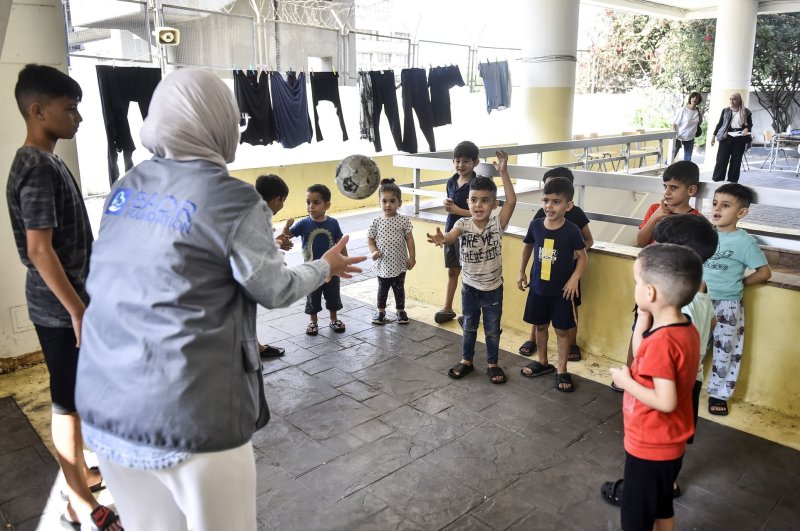1 of 4 | Displaced Lebanese children play at the Omar Farroukh public school in the Tarik al Jadideh neighborhood of Beirut in mid-October. The school was transformed into a shelter to house displaced people in Beirut. File photo by Fadel Itani/ UPI |
License PhotoBEIRUT, Lebanon, Dec. 5 (UPI) — The devastating Israel-Hezbollah war has deepened Lebanon’s education crisis, with further learning losses, resource shortages and little attention paid to quality instruction, according to a study by the University of Cambridge and the Center for Lebanese Studies released Thursday.
The study, undertaken at the end of October based on a survey and interviews with 1,151 parents and teachers, warned that children in Lebanon have already lost up to 60% of school time over the past six years.
The 62-page report is called Education Under Fire: A Rapid Study of Parents’ and Teachers’ Readiness for School Amidst Israeli Attacks on Lebanon.
Schools already were under extreme pressure due to a decade of “compounded crises,” it noted, citing an influx of Palestinian and Syrian refugees, the 2019 financial crisis, the Beirut port explosion a year later and the COVID-9 pandemic.
It added that students have already missed more than 760 teaching days due to strikes, disruption and closures since 2018.
The conflict that broke out between Hezbollah and Israel in October 2023 and turned into a large-scale war in mid-September, “has deepened learning losses that were already near-catastrophic,” said Maha Shuayb, director of the Center for Lebanese Studies.
According to the study, more than 1 million students and 45,000 teachers had been affected directly by the conflict by November. About 40% of public schools had been converted into shelters. A further 30% were in war zones, severely limiting space for schooling.
Imad Achkar, the director general of the Ministry of Education, said some 370,000 students have been forced to leave their homes and schools in Beirut’s southern suburbs and four governorates in southern and eastern Lebanon. Nearly 40,000 teachers were displaced.
Achkar said 505 schools out of total of 1,275 were turned into shelters to accommodate displaced families fleeing the targeted regions.
From October 2023 to mid-September, when Israel expanded its attacks on a large scale, some 80 schools in the border area of southern Lebanon were forced to close and “families with their children moved to more secure areas where we secured online education for them,” Achkar told UPI.
“We also conducted the official exams so not to lose another year of education and insisted on starting the new school year,” he said.
While the war was raging, the Ministry of Education adopted a double shift in some 350 schools, at which 272,000 students were registered and 210,000 started schooling onsite.
With a cease-fire in place since last week, Achkar said, 85% of the schools are preparing to reopen, noting that 350 were damaged and two destroyed in south Lebanon.
“We started to repair the damaged schools and in-person education while we will keep online teaching, especially [because] some 450,000 people have fled to Iraq, Syria and Jordan,” he said.
The study was conducted when many of the survey participants were living in shelters or overcrowded shared accommodation and where online learning — often the only option available — was difficult.
With more than 1.3 million civilians displaced since Israel escalated its military operations in Lebanon, the study noted that financial pressures, exacerbated by the war, have further disrupted education.
Some 77% of parents and 66% of teachers said the conflict reduced their incomes amid rising living costs, while only 62% of teachers and 49% of parents said they had an Internet connection.
Shuyab, the Center for Lebanese Studies director, called for urgently needed “flexible, inclusive, multi-agency strategies … to ensure education reaches those who need it most.”
“Without thorough response planning, existing inequalities will become more entrenched, leaving entire sections of the younger generation behind,” she said.
According to the study, refugee children and students with disabilities have been disproportionately affected and “are among those who face the greatest risk of missing out further, even as the education system struggles to recover.”
The researchers estimated that as many as 5,000 children with disabilities could be out of school. They stressed that “the focus has largely been on resuming schooling, with little attention paid to quality of learning,” thus the need for “a far more inclusive response plan.”
Achkar explained that Lebanon lost up to 35% of its teachers, “the most qualified” who took jobs in the Gulf and other countries due to the financial crisis.
As for the Syrian refugees, he said some 200,000 were enrolled in Lebanon’s public schools last year and have “exhausted our resources.” Foreign funding to support them dropped from $600 per year per student at the beginning of the Syrian crisis to barely $20 now.
The study warned that even if the ceasefire holds and Lebanon returns to normality, challenges remain.
“We have grave reservations about the quality, consistency and accessibility of education in the medium term,” said Yusuf Sayed, a professor of education at University of Cambridge, emphasizing the need for “a flexible plan and multi-agency support.”
